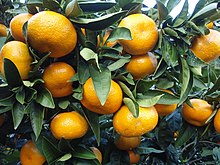溫州蜜柑
溫州蜜柑(學名:Citrus unshiu),又稱蜜柑、無核橘,是芸香科柑橘屬常綠灌木。
| 溫州蜜柑 | |
|---|---|

| |
| 科學分類 | |
| 界: | 植物界 Plantae |
| 演化支: | 維管束植物 Tracheophyta |
| 演化支: | 被子植物 Angiosperms |
| 演化支: | 真雙子葉植物 Eudicots |
| 演化支: | 薔薇類植物 Rosids |
| 目: | 無患子目 Sapindales |
| 科: | 芸香科 Rutaceae |
| 屬: | 柑橘屬 Citrus |
| 種: | 溫州蜜柑 C. unshiu
|
| 二名法 | |
| Citrus unshiu | |
名稱
編輯溫州蜜柑一名始見於日本江戶時代晚期,因被認為產於中國浙江的溫州而得名,又被認為在九州肥後國天草郡西仲島(現鹿兒島縣長島町)變異而曾在九州稱為仲島蜜柑[2]。溫州蜜柑經由日本傳入西方世界,故以溫州的日語發音「うんしゅう Unshū」得種小名「unshiu」。[3][4][5][6]
分類
編輯田中長三郎的分類法將溫州蜜柑與橘劃分爲不同物種,而沃爾特·譚尼森·施永高的分類法視溫州蜜柑爲橘的變種。[7]遺傳分析表明,溫州蜜柑是高度自交的橘柚雜交種,其基因組有22%來自柚,多於大多數橘。其由含柚基因組少的黃陵廟或紀州變種(田中分類法爲柑橘屬橘種)同柚或其雜交種雜交,然後將所得品種與前者的另一種回交而得。[8][9]
特徵
編輯溫州蜜柑是極爲甘甜的柑橘品種。[10]其通常無籽,大小與其他橘種相似。果皮鬆散,呈皮革狀,比其他柑橘易剝。[11]外皮通常光滑或略粗糙,呈中小型扁平體球狀。[12][13]通常有10至12個易分離、有韌膜的部分。[13]肉質脆弱。[11]果皮顏色通常取決於氣候,潮濕地區成熟時可能仍是綠色,夜晚涼爽地區成熟時橙裏透紅。[13][14]
溫州蜜柑耐寒,較冷地區果實在較冷時會更甜。成熟植株可在–9℃乃至–11℃的環境中存活數小時。[15]可食用柑橘品種中,只有金橘更耐寒。溫州蜜柑少有刺,因此受人歡迎。[13]可用種子種植,首次結果大約需8年,也可嫁接至其他柑橘類砧木,如枳。[13]
歷史
編輯溫州蜜柑原產溫州,唐代作為貢品,南宋韓世忠之子韓彥直曾於瑞安府任時著《橘錄校注》(又稱《永嘉橘錄》《橘錄》)系統介紹其品種與種植。明朝永樂年間日本僧人智惠將其帶回九州鹿兒島。1878年美國派日本特使羅伯特·布魯斯·范·瓦爾肯堡將軍夫人以日本產地薩摩(薩摩/さつま Satsuma)名之[16]。臺灣北部於日治時期由鹿兒島引進,亦有種植。
分佈
編輯變種
編輯溫州蜜柑的變種主要是橘。[18]此外還有一些雜交品種。
可能非雜交的品種
編輯雜交品種
編輯參考文獻
編輯- ^ 米倉浩司; 梶田忠. Citrus unshiu (Swingle) Marcow.. 和名-學名インデックス(YList). 2003 [2020-06-08]. (原始內容存檔於2021-03-20).
- ^ 「こたつでミカン」の光景はなぜ生まれたのか 冬の風物詩の盛衰、かつては迷信で避けられていた時代も. 佐藤成美: 3. 2019-02-01 [2021-06-30]. (原始內容存檔於2019-02-05).
- ^ Schlegel, Rolf. Dictionary of Plant Breeding 2nd. CRC Press. 2009: 437 [2020-12-22]. ISBN 9781439802434. (原始內容存檔於2020-11-06).
It's named after, Unsyu, China; in Japan it is known as "unshu mikan," in China, as "wenzhou migan"; recorded cultivation of the "wenzhou migan" date back some 2,400 years; it was listed as a tribute item for Imperial consumption in the TANG Dynasty; the best record of the cultivation of this variety in ancient China is from Jijia Julu, written by Han YAN, the governor of the region and published in 1178
- ^ Japanese Mikan and Satsuma Oranges. hawaii.edu. [2020-12-22]. (原始內容存檔於2016-03-04).
Mikan is a tangerine-like citrus fruit that is grown in warmer regions of Japan in large quantities. Many different varieties have been introduced to Japan from China since the eighth century, but since the late 19th century the most important variety has been the unshu.
- ^ Citrus unshiu. Germplasm Resources Information Network (GRIN). USDA. [2017-12-11]. "probable origin in Kyushu islands, Japan or imported from China to Japan."
- ^ 御前明良. 紀州有田みかんの起源と発達史. 經濟理論 (和歌山大學). 1999-11, 292: 97–118. (原始內容存檔於2001-01-10) (日語).
【田中博士は永年にわたる調査から「温州みかん」は鹿児島県出水郡長島(現東町)が原産地である。中国浙江省や黄岩県から伝来していた「早桔」か「慢桔」または「天台山桔」類のミカンが長島で『偶発実生』したもので、時期は《江戸初期》のころ発現したものであろうと結論された】
- ^ Froelicher, Yann; Mouhaya, Wafa; Bassene, Jean-Baptiste; Costantino, Gilles; Kamiri, Mourad; Luro, Francois; Morillon, Raphael; Ollitrault, Patrick. New universal mitochondrial PCR markers reveal new information on maternal citrus phylogeny. Tree Genetics & Genomes. 2011, 7: 49–61 [2020-12-22]. doi:10.1007/s11295-010-0314-x. (原始內容存檔於2021-01-22).
- ^ Wu, Guohong Albert; Terol, Javier; Ibanez, Victoria; López-García, Antonio; Pérez-Román, Estela; Borredá, Carles; Domingo, Concha; Tadeo, Francisco R; Carbonell-Caballero, Jose; Alonso, Roberto; Curk, Franck; Du, Dongliang; Ollitrault, Patrick; Roose, Mikeal L. Roose; Dopazo, Joaquin; Gmitter Jr, Frederick G.; Rokhsar, Daniel; Talon, Manuel. Genomics of the origin and evolution of Citrus (PDF). Nature. 2018, 554 (7692): 311–316 [2020-12-22]. Bibcode:2018Natur.554..311W. PMID 29414943. doi:10.1038/nature25447. (原始內容存檔 (PDF)於2019-09-04). and Supplement
- ^ 清水德朗; 北島宣; 野中圭介; 吉岡照高; 太田智; 後藤新悟; 豐田敦; 藤山秋佐夫; 望月孝子; 長崎英樹; 神沼英里; 中村保一. Hybrid Origins of Citrus Varieties Inferred from DNA Marker Analysis of Nuclear and Organelle Genomes. PLOS ONE. 2016-11-30, 11 (11): e0166969. Bibcode:2016PLoSO..1166969S. PMC 5130255 . PMID 27902727. doi:10.1371/journal.pone.0166969. e0166969.
- ^ Elisa Bosley. In Season: Satsuma Oranges. CookingLight. [2015-02-25]. (原始內容存檔於2021-03-20).
- ^ 11.0 11.1 Silvia Bautista-Baños; Gianfranco Romanazzi; Antonio Jiménez-Aparicio. Chitosan in the Preservation of Agricultural Commodities. Elsevier Science. 2016: 76 [2020-12-22]. ISBN 978-0-12-802757-8. (原始內容存檔於2021-03-20).
- ^ frostowari. citrusvariety.ucr.edu. [2020-04-23]. (原始內容存檔於2021-03-20).
- ^ 13.0 13.1 13.2 13.3 13.4 Andersen, Peter C.; Ferguson, James J. The Satsuma Mandarin. University of Florida Electronic Data Information Source. 2019 [2020-04-23]. (原始內容存檔於2021-03-02).
- ^ 14.0 14.1 P. C. Andersen; J. J. Ferguson; T. M. Spann. HS195/CH116: The Satsuma Mandarin. ufl.edu. 2019-04-05 [2020-12-22]. (原始內容存檔於2021-03-02).
- ^ "Orange Frost", a new cold hardy citrus. PLANTanswers. [2020-12-22]. (原始內容存檔於2019-09-21).
- ^ 存档副本. [2018-02-22]. (原始內容存檔於2018-02-23).
- ^ Saunt, James. Citrus varieties of the world : an illustrated guide 2nd. Norwich, England: Sinclair International Ltd. 2000. ISBN 1872960014. OCLC 45130256.
- ^ Barkley, NA; Roose, ML; Krueger, RR; Federici, CT. Assessing genetic diversity and population structure in a citrus germplasm collection utilizing simple sequence repeat markers (SSRS). Theoretical and Applied Genetics. 2006, 112 (8): 1519–1531 [2020-12-22]. PMID 16699791. doi:10.1007/s00122-006-0255-9. (原始內容存檔於2021-03-09).
- ^ Kinkoji unshiu mandarin (graft) hybrid Citrus neo-aurantium. Citrus Variety Collection. University of California Riverside. [2020-12-22]. (原始內容存檔於2014-10-22).
- ^ 菅原邦明; 大和田厚; 森口卓哉; 大村三男. Identification of Citrus Chimeras by RAPD Markers (PDF). HortScience. 1995, 30 (6): 1276–1278 [2020-12-22]. doi:10.21273/HORTSCI.30.6.1276. (原始內容存檔 (PDF)於2021-03-20).